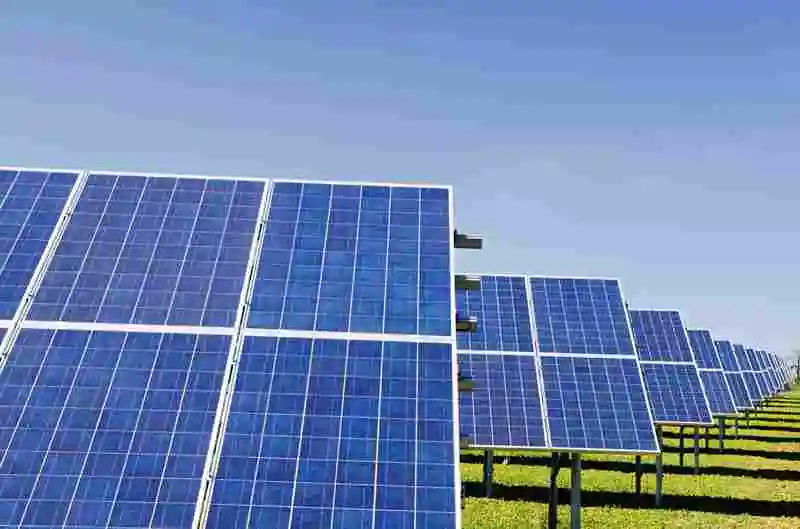Are you ready to revolutionize your energy solutions? In a world where sustainability and innovation go hand in hand, the XCV Panel is making waves as the next big thing in renewable energy. Say goodbye to traditional solar panels and hello to a cutting-edge solution that combines efficiency, integration, and sleek design all in one. Whether you’re a homeowner looking to reduce your carbon footprint or a business owner seeking cost-effective energy solutions, it’s time to dive into the world of these Panels and discover why they may be the right choice for you. So buckle up and join us on this electrifying journey!
XCV Panel: Where Innovation Meets Integration
Table of Contents
In the ever-evolving world of renewable energy, new technologies are constantly emerging to meet the growing demand for sustainable solutions. One such innovation is the XCV Panel, a game-changer in the field of solar energy.
So what exactly is this range of Panel? It’s a cutting-edge solar panel that combines efficiency with seamless integration into various applications. Unlike traditional solar panels, which can be bulky and cumbersome, the This type of Panel boasts a sleek design that seamlessly blends into any environment.
But how does it work? The secret lies in its advanced photovoltaic technology, which converts sunlight into electricity more efficiently than ever before. This means you can generate more power using fewer panels – saving space and maximizing your energy output.
The Benefits of XCV Panels over their traditional counterparts are numerous. Their streamlined design makes them ideal for both residential and commercial installations where aesthetics matter. Their superior efficiency ensures maximum energy production even in low-light conditions. They require minimal maintenance compared to other systems on the market.
The applications for XCV Panels are vast and varied. From rooftops to facades, these panels can be seamlessly integrated into buildings of all shapes and sizes. They’re also perfect for off-grid locations where access to conventional power sources may be limited.
When it comes to types of XCV Panels available on the market today include monocrystalline and polycrystalline options – each offering unique advantages depending on your specific needs and preferences.
Installing an XCV Panel is relatively straightforward; however, professional installation is recommended to ensure optimal performance and safety standards are met.
While there are many advantages to using an XCV Panel system, it’s essential to consider some drawbacks as well. These include higher initial costs compared to traditional solar panels due to their advanced technology features.
Is an XVC panel right for you? That depends on your specific circumstances and priorities. If you value efficiency, aesthetics, and long-term savings,
What is the XCV Panel?
The XCV Panel represents a cutting-edge innovation in energy solutions. It combines advanced technology with seamless integration, offering a revolutionary approach to harnessing solar power. This innovative panel is designed to maximize energy efficiency and provide sustainable power generation.
But what sets the this Panel apart from traditional solar panels? Well, it’s all about the integration. Unlike traditional panels that are typically mounted on rooftops or standalone structures, this seamlessly integrates into various surfaces such as windows, walls, and even furniture. It blends effortlessly into its surroundings while capturing sunlight and converting it into usable electricity.
So how does this remarkable panel work? The secret lies in its transparent design which allows light to pass through while absorbing solar energy. The integrated photovoltaic cells within the panel then convert this captured light into electricity that can be used to power homes, buildings, or even charge electric vehicles.
One of the key benefits of opting for this technology over traditional solar panels is its versatility. With their sleek and unobtrusive design, these panels can be installed virtually anywhere without compromising aesthetic appeal. Whether you want to integrate them into your home’s windows or create a stunning feature wall powered by renewable energy, the possibilities are endless!
In addition to their versatility, These Panels also offer improved efficiency compared to traditional alternatives. Their advanced technology ensures maximum sunlight absorption and increased electrical output per square foot. This means you’ll get more bang for your buck when it comes to generating clean energy for your household or business.
When it comes to applications of these Solar Panels, the sky’s the limit! From residential buildings seeking sustainable power solutions to commercial spaces aiming for green certifications like LEED (Leadership in Energy and Environmental Design), these panels offer an ideal solution for anyone looking to reduce their carbon footprint while enjoying long-term cost savings.
There are several types of Solar Panels available on the market today, each with its own unique features and specifications. Some panels are designed specifically for many other system softwares like eleveo and more.
How does the XCV Panel work?
The XCV Panel is a cutting-edge energy solution that harnesses the power of the sun in an innovative way. But how exactly does it work? Let’s dive into the details!
At its core, this Panel is equipped with advanced solar technology that captures sunlight and converts it into electricity. Unlike traditional solar panels, which rely on photovoltaic cells to generate power, takes a different approach.
Instead of using individual cells, they utilizes a unique grid system that maximizes energy production. The panel consists of interconnected modules that work together to capture sunlight from multiple angles. This design allows for greater efficiency and generates more electricity compared to standard solar panels.
In addition to its grid system, they also incorporates smart tracking technology. This means that as the position of the sun changes throughout the day, the panel can adjust its angle and orientation accordingly. By constantly optimizing its position relative to sunlight, it ensures maximum energy absorption at all times.
Furthermore, each module within an X C V Panel is equipped with microinverters. These devices convert direct current (DC) generated by sunlight into alternating current (AC), which can be used to power homes or businesses directly or stored in batteries for later use.
Through its grid system, smart tracking technology, and microinverters, the XCV Panel works harmoniously to efficiently capture and convert sunlight into usable electricity. It’s a true testament to innovation in renewable energy solutions!
Benefits of XCV Panel over traditional solar panels
The Benefits over traditional solar panels are:
1. Increased efficiency: One of the major advantages of XCV Panels is their higher efficiency compared to traditional solar panels. With advanced technology and innovative design, they can harness more sunlight and convert it into usable energy. This means you can generate more power with fewer panels, saving space and costs.
2. Improved aesthetics: Traditional solar panels are bulky and often stand out on rooftops or in outdoor installations. On the other hand, they have a sleeker and more streamlined design that blends seamlessly with any architectural style. They can be integrated into building facades or even replace conventional materials like glass or metal, adding a modern touch while generating clean energy.
3. Enhanced durability: They are built to withstand harsh weather conditions such as extreme temperatures, heavy rain, snowfall, or strong winds. Unlike traditional solar panels which may become damaged or less efficient over time due to exposure to these elements, They offer increased durability and longer lifespan.
4. Flexibility in installation: Traditional solar panel systems require significant roof space for installation due to their size and orientation requirements for optimal sun exposure. However, They provide greater flexibility as they can be installed vertically on walls or as part of architectural features without compromising performance.
5. Increased cost-effectiveness: While the initial investment for installing They may be slightly higher than traditional solar panels, the long-term cost savings make them a worthwhile investment choice.
The improved efficiency means you will generate more electricity from the same amount of sunlight,resulting in lower utility bills over time.
Additionally, the reduced maintenance needs due to improved durability contribute towards lowering overall expenses.
Applications of XCV Panel
The versatility of this Innovative, Upgraded & Smart Solar Panels extends beyond traditional solar energy solutions, making them ideal for various applications. Here are some exciting ways these innovative panels can be utilized:
1. Residential Use: They can be installed on rooftops or incorporated into the design of a home to generate renewable energy. Their sleek and compact design makes them aesthetically pleasing while reducing reliance on grid power.
2. Commercial Buildings: From office complexes to shopping malls, the integration of these panels in commercial buildings allows businesses to reduce their carbon footprint and save on electricity costs simultaneously.
3. Agriculture: Farmers can harness the power of the sun with panels to provide sustainable energy for irrigation systems, barns, and other agricultural operations.
4. Outdoor Recreation: Remote cabins, camping sites, and RVs can benefit from portable versions of panels that enable off-grid living without compromising convenience or comfort.
5. Urban Infrastructure: Cities worldwide are embracing renewable energy technologies like to power streetlights, bus shelters, and public charging stations for electric vehicles.
6. Emergency Preparedness: In times of natural disasters or power outages, having an independent source of electricity is crucial. With their adaptability and portability features offer reliable backup power solutions during emergencies.
Whether it’s for residential use or large-scale industrial projects, there is no shortage of applications when it comes to harnessing the potential offered by XCV panel technology!
Main Types of XCV Panels
When it comes to choosing the right panel for your energy needs, you’ll find a variety of options available in the market. Each type offers unique features and benefits, catering to different requirements and preferences.
1. Monocrystalline: These panels are made from a single crystal structure, resulting in high efficiency and aesthetic appeal. They are known for their sleek black appearance and perform well under low light conditions.
2. Polycrystalline: Made from multiple crystal structures, these panels offer good performance at a lower cost compared to monocrystalline panels. They have a blueish hue and are suitable for larger installations where cost-effectiveness is important.
3. Thin-Film: This type uses thin layers of semiconductor material deposited onto glass or other substrates. Thin-film panels can be flexible, lightweight, and less expensive than crystalline silicon panels. They also perform better in shaded or high-temperature environments.
4. Bifacial: These innovative panels capture sunlight from both sides, increasing overall energy production by up to 30%. Bifacial panels can be installed on tracking systems or elevated off the ground to maximize their potential.
5. Building-integrated Photovoltaic (BIPV): This type seamlessly integrates solar cells into building materials such as windows, roofs, or facades. BIPV provides an aesthetically pleasing solution that blends with architectural designs while generating clean energy.
6. Floating Solar: As the name suggests, these PV modules float on water bodies like reservoirs or lakes instead of being mounted on land surfaces. Floating solar arrays help save space while reducing evaporation rates from water bodies.
7. Organic Solar Cells (OSCs): OSCs utilize organic compounds that conduct electricity when exposed to sunlight.
These types of solar panels have the potential to be flexible, lightweight, and low-cost. Although still
Best way to install XCV Panel
Installing XCV Panels is a crucial step in harnessing the power of renewable energy. To ensure optimal performance and longevity, it’s important to follow the best installation practices. Here are some key steps to consider when installing these Panels:
1. Location: Choose a spot that receives ample sunlight throughout the day with minimal shading from trees or buildings. This will maximize the panel’s efficiency.
2. Orientation: Position the panels facing south (in the northern hemisphere) or north (in the southern hemisphere) for maximum solar exposure.
3. Mounting: Use sturdy and secure mounting brackets to attach the panels to your roof or ground surface. Ensure they are properly aligned and angled according to your location’s latitude.
4. Wiring: Connect each panel in series using high-quality solar cables and connectors to create an efficient electrical circuit.
5. Inverter Installation: Install a compatible inverter near your panels to convert DC power generated by solar cells into AC power suitable for household use.
6. Safety Measures: Take necessary precautions during installation, such as wearing safety gear, turning off electricity supply, and following local building codes.
7. Monitoring System Setup: Set up a monitoring system to track energy production and detect any issues promptly.
Remember, professional installation by certified technicians is always recommended for ensuring optimal performance, compliance with regulations, and safety standards when installing the said Panels.
Drawbacks of XCV Panel
While the XCV Panel offers numerous benefits and innovative features, it is important to consider its drawbacks before making a decision. One drawback is the initial cost. Compared to traditional solar panels, They can be more expensive upfront due to their advanced technology and integration capabilities.
Additionally, another drawback is their dependence on sunlight. Like traditional solar panels, They require direct sunlight to generate electricity efficiently. Therefore, if you live in an area with limited sunshine or experience frequent cloudy days, the energy production of them may be significantly reduced.
Furthermore, maintenance can also pose a challenge with the said technology. The integration of different components within each panel means that any malfunction or damage requires specialized expertise for repair or replacement.
Moreover, installation complexity can be another downside of these system panels. As these panels are designed to integrate seamlessly into various structures such as windows and building facades, professional installation is crucial to ensure proper functionality and avoid any potential issues.
While advancements in technology continue to make them more efficient over time, currently XCV Panels have lower energy conversion rates compared to conventional solar panels.
Considering these drawbacks will help you make an informed decision about whether the use of these smart Panels aligns with your specific needs and circumstances.
Is XCV Panel right for you?
To determine if this innovative energy solution aligns with your needs, it’s important to consider a few key factors.
Assess your energy requirements. Are you looking for a sustainable and cost-effective way to power your home or business? If so, They could be an excellent fit. These panels are designed to maximize energy output while minimizing costs, making them an attractive option for those seeking long-term savings.
Consider your location and available space. They can be installed on various surfaces including rooftops, walls, and even windows. They are versatile in their application and can work well in both residential and commercial settings.
Another aspect to evaluate is the environmental impact. If reducing carbon emissions and embracing clean energy sources is important to you, then choosing them aligns perfectly with these goals. By harnessing solar power through advanced technology, these panels contribute significantly towards a greener future.
Additionally, think about the longevity of your investment. The durability of these Panels ensures they will withstand harsh weather conditions over time without compromising performance. This means less maintenance and more peace of mind for years to come.
Consider financial considerations such as upfront costs versus long-term benefits. While initial installation expenses may be higher compared to traditional solutions; the significant reduction in monthly electricity bills allows for potential savings down the line.
Ultimately though, deciding if they are right for you comes down to evaluating your specific needs in terms of sustainability goals, budget constraints, and available space.
Consider reaching out to professionals who specialize in renewable energy systems.
They can provide personalized advice based on thorough assessments tailored specificallytoyour unique circumstances.
Alternatives to XCV Panels
While XCV panels offer innovative and integrated energy solutions, they may not be the right fit for everyone. Thankfully, there are several alternatives to consider when it comes to harnessing renewable energy.
One popular alternative is traditional solar panels. These panels have been around for decades and have proven their reliability in generating clean energy from the sun. While they may not offer all the advanced features of them, traditional solar panels are still a cost-effective option for many homeowners and businesses.
Another alternative worth exploring is wind turbines. If you live in an area with consistent winds, installing a wind turbine can be an excellent way to generate electricity. Wind power is a clean and abundant resource that can help reduce your reliance on fossil fuels.
Hydroelectric power is another viable alternative to these. By utilizing the force of flowing water, hydroelectric systems can generate electricity efficiently and sustainably. This option works best if you have access to a nearby river or stream with sufficient water flow.
Geothermal energy is yet another alternative that utilizes heat from within the Earth’s crust to produce electricity or heat buildings directly. Geothermal systems require initial investment but offer long-term savings on heating and cooling costs.
Biomass technology harnesses organic matter such as wood pellets or agricultural waste to produce heat or electricity. It’s a renewable source that reduces dependence on fossil fuels while also providing waste management benefits.
If you’re looking for something more portable, consider investing in solar-powered gadgets like chargers or lights. These small-scale options allow you to utilize solar energy without committing to larger installations.
Remember, each alternative has its own advantages and limitations depending on your location, budget, and specific needs. Exploring these alternatives will help you make an informed decision about which solution aligns best with your goals for sustainable living.
Conclusion
When it comes to choosing the right energy solution for your needs, they offers a cutting-edge alternative to traditional solar panels. With its innovative design and integration capabilities, this technology is revolutionizing the way we harness and utilize renewable energy.
They combines efficiency, versatility, and sustainability in one package. Its unique features allow for seamless integration into various settings, making it suitable for both residential and commercial applications. Whether you’re looking to power your home or business with clean energy or seeking an eco-friendly solution for remote locations, they can meet your requirements.
With benefits such as higher efficiency rates, improved aesthetics, increased durability, easy installation process, and compatibility with different systems – the said technology outshines traditional solar panels in multiple ways.
However, it’s important to consider any drawbacks before making a decision. While the initial cost of installing XCV Panels may be higher compared to traditional options, their long-term benefits often outweigh this investment.
Whether or not XCV Panels are right for you depends on your specific needs and priorities. If you value high performance coupled with sleek design and want to reduce your carbon footprint while maximizing energy savings in the long run – then the XCV Panel could be an ideal choice for you.






